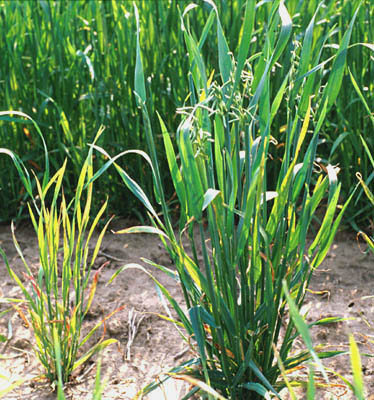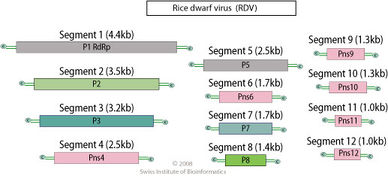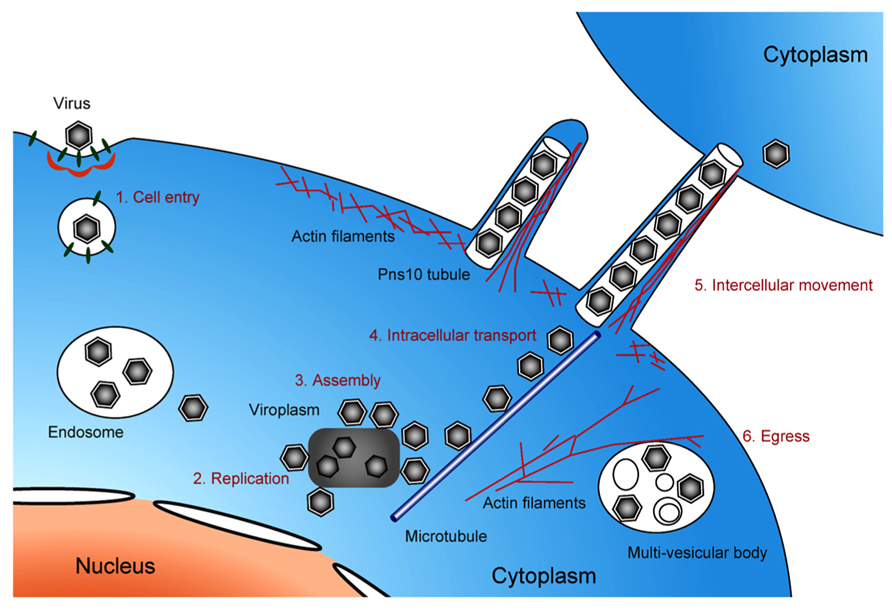Rice Dwarf Virus: Difference between revisions
(Created page with "{{Uncurated}} ==Classification== Virus, dsRNA viruses, Reoviridae, Phytoreovirus, Rice Dwarf Virus ===Species=== Rice Dwarf Virus {| | height="10" bgcolor="#FFDF95" | '''NCB...") |
|||
| (49 intermediate revisions by the same user not shown) | |||
| Line 1: | Line 1: | ||
{{Uncurated}} | {{Uncurated}} | ||
==Classification== | ==Classification== | ||
Virus, dsRNA viruses, Reoviridae, Phytoreovirus, Rice Dwarf Virus | Virus, dsRNA viruses, Reoviridae, Phytoreovirus, Rice Dwarf Virus | ||
[[File:BarleyYellowDwarf16.jpg|left|frame|none|alt=Alt text|Infected plant versus healthy plant|100px|x120px]] | |||
===Species=== | ===Species=== | ||
Rice Dwarf Virus | Rice Dwarf Virus | ||
| Line 11: | Line 12: | ||
''Genus species'' | ''Genus species'' | ||
Phytoreovirus Rice Dwarf Virus | Phytoreovirus Rice Dwarf Virus | ||
==Description and Significance== | ==Description and Significance== | ||
The Rice Dwarf Virus was the first studied plant | The Rice Dwarf Virus was the first studied plant virus. It has since been used as a model teaching tool for understanding plant virus mechanisms. RDV uses an insect vector to infect rice and wheat plants. The virus is an isohedral double shelled virus, ranging from 70-75 nm in diameter. There are three strains of the RDV: O, D84, and S. Strain S is the most virulent and causes the most severe symptoms. The RDV is isolated to China and Japan, but the detrimental effects it has on the grain industry impacts globally. [1,3] | ||
==Genome Structure== | ==Genome Structure== | ||
The Rice Dwarf Virus is a double-stranded linear RNA virus. The dsRNA consists of 12 segments. Each segment ranges from 4.4 kb pairs to 0.83 kb pairs. The total size of the genome is 25.13 kb pairs. The base composition of the genome is 42-48% C-G. Segments S1, S2, S3, S5, S7, and S8 are known to code for functional proteins. These proteins code for RNA Polyemerase, capsid structure, cell absorption, and nucleic acid binding. The genome of the RDV has been sequenced and is often used as a tool to understanding viral plant pathogens. | [[File:Phytoreovirus_genome.jpg|right|388px|x176px]] | ||
The Rice Dwarf Virus is a double-stranded linear RNA virus. The dsRNA consists of 12 segments. Each segment ranges from 4.4 kb pairs to 0.83 kb pairs. The total size of the genome is 25.13 kb pairs. The base composition of the genome is 42-48% C-G. Segments S1, S2, S3, S5, S7, and S8 are known to code for functional proteins. These proteins code for RNA Polyemerase, capsid structure, cell absorption, and nucleic acid binding. The other six segments are non-coding proteins. The genome of the RDV has been sequenced and is often used as a tool to understanding viral plant pathogens. [3] | |||
==Cell Structure, Metabolism and Life Cycle== | ==Cell Structure, Metabolism and Life Cycle== | ||
The RDV is an isohedral virus containing 32 capsomeres. The capsomeres are arranged in a conspicuous manner. The virons are isometeric and not enveloped. The virus has an angular profile. The RDV enters the host cell then begins replication and assembly. The viruses then participate in intracellular transport by taking over host mechanisms. Tubulars are created and | The RDV is an isohedral virus containing 32 capsomeres. The capsomeres are arranged in a conspicuous manner. The virons are isometeric and not enveloped. The virus has an angular profile. The RDV enters the host cell then begins replication and assembly. The viruses then participate in intracellular transport by taking over host mechanisms. Tubulars are created using the host inner and outer membrane and extends the structure outward to other host cells. This enables the RDV to move intracellularly into un-infected host cells and being replication. [3,4] | ||
==Ecology and Pathogenesis== | ==Ecology and Pathogenesis== | ||
RDV is found in the rice paddies of China and Japan. The viruses participate in transovarial transmission through leafhopper insects. The insects become infected with the virus and can then eat other plants and infect them or reproduce and pass the virus onto its offspring. An infected rice plant often shows symptoms such as stunted growth, shortened internodes, chlorotic flecks at infection site, and inhibited root growth (only extend horizontally). There is a 10-35 day incubation period in the insect, depending on the species. There is also a 8-27 day incubation period in the plant. Global grain industries are often hindered when an outbreak of RDV appears. Prices of cereals and grains increase. Combating an RDV infection is often complicated. There are three steps to the eradication of a disease: prophylaxis, therapy, and immunization. Since the infection does not occur in the seeds or seedbed, prophylaxis treatment is useless. Therapy, such as integrating pest control and management through chemicals has been the most effective in containing and controlling Rice Dwarf Virus. [1,2] | |||
[[File:Pathogenicity.jpg|frame|none|left|375px|x260px|alt=Alt text|Viral infection with tubular structures]] | |||
<br><br> | <br><br> | ||
==References== | ==References== | ||
http://pdf.usaid.gov/pdf_docs/pnaaa923.pdf Ling K. "Rice Virus Diseases." International Rice Research Institute. 1972 p. 55-62. | http://pdf.usaid.gov/pdf_docs/pnaaa923.pdf Ling K. "Rice Virus Diseases." International Rice Research Institute. 1972 p. 55-62. | ||
http://www.iita.org/c/document_library/get_file?uuid=91e91c5d-a854-4eba-80ae-c677236a0e9f&groupId=25357 Abo M, Fadhila H. "Epidemiology and Management of Rice Viruses and Virus Diseases."National Cereals Institute. 1991 p. 113-121. | http://www.iita.org/c/document_library/get_file?uuid=91e91c5d-a854-4eba-80ae-c677236a0e9f&groupId=25357 Abo M, Fadhila H. "Epidemiology and Management of Rice Viruses and Virus Diseases."National Cereals Institute. 1991 p. 113-121. | ||
http://pvo.bio-mirror.cn/descr686.htm Brunt A, Crabtree K, Dallwitz M, Gibbs A, Watson L, Zurcher E. "Plant Viruses Online: Descriptions and Lists from the VIDE Database." 1996. | http://pvo.bio-mirror.cn/descr686.htm Brunt A, Crabtree K, Dallwitz M, Gibbs A, Watson L, Zurcher E. "Plant Viruses Online: Descriptions and Lists from the VIDE Database." 1996. | ||
http://jvi.asm.org/content/80/17/8593.full Wei T, Kikuchi A, Moriyasu Y, Suzuki N, Shimizu T, Hagiwara K, Chen H, Takahashi M, Ichiki-Uehara T, Omura T. "The Spread of Rice Dwarf Virus among Cells among its Insect Vector Exploits Virus-Induced Tubular Structures." Journal of Virology. 2006 vol 80. | |||
==Author== | ==Author== | ||
Page authored by | Page authored by Chelsea A. Wissel, student of Prof. Jay Lennon at IndianaUniversity. | ||
<!-- Do not remove this line-->[[Category:Pages edited by students of Jay Lennon at Indiana University]] | <!-- Do not remove this line-->[[Category:Pages edited by students of Jay Lennon at Indiana University]] | ||
Latest revision as of 22:59, 30 April 2014
Classification
Virus, dsRNA viruses, Reoviridae, Phytoreovirus, Rice Dwarf Virus
Species
Rice Dwarf Virus
|
NCBI: Taxonomy |
Genus species Phytoreovirus Rice Dwarf Virus
Description and Significance
The Rice Dwarf Virus was the first studied plant virus. It has since been used as a model teaching tool for understanding plant virus mechanisms. RDV uses an insect vector to infect rice and wheat plants. The virus is an isohedral double shelled virus, ranging from 70-75 nm in diameter. There are three strains of the RDV: O, D84, and S. Strain S is the most virulent and causes the most severe symptoms. The RDV is isolated to China and Japan, but the detrimental effects it has on the grain industry impacts globally. [1,3]
Genome Structure
The Rice Dwarf Virus is a double-stranded linear RNA virus. The dsRNA consists of 12 segments. Each segment ranges from 4.4 kb pairs to 0.83 kb pairs. The total size of the genome is 25.13 kb pairs. The base composition of the genome is 42-48% C-G. Segments S1, S2, S3, S5, S7, and S8 are known to code for functional proteins. These proteins code for RNA Polyemerase, capsid structure, cell absorption, and nucleic acid binding. The other six segments are non-coding proteins. The genome of the RDV has been sequenced and is often used as a tool to understanding viral plant pathogens. [3]
Cell Structure, Metabolism and Life Cycle
The RDV is an isohedral virus containing 32 capsomeres. The capsomeres are arranged in a conspicuous manner. The virons are isometeric and not enveloped. The virus has an angular profile. The RDV enters the host cell then begins replication and assembly. The viruses then participate in intracellular transport by taking over host mechanisms. Tubulars are created using the host inner and outer membrane and extends the structure outward to other host cells. This enables the RDV to move intracellularly into un-infected host cells and being replication. [3,4]
Ecology and Pathogenesis
RDV is found in the rice paddies of China and Japan. The viruses participate in transovarial transmission through leafhopper insects. The insects become infected with the virus and can then eat other plants and infect them or reproduce and pass the virus onto its offspring. An infected rice plant often shows symptoms such as stunted growth, shortened internodes, chlorotic flecks at infection site, and inhibited root growth (only extend horizontally). There is a 10-35 day incubation period in the insect, depending on the species. There is also a 8-27 day incubation period in the plant. Global grain industries are often hindered when an outbreak of RDV appears. Prices of cereals and grains increase. Combating an RDV infection is often complicated. There are three steps to the eradication of a disease: prophylaxis, therapy, and immunization. Since the infection does not occur in the seeds or seedbed, prophylaxis treatment is useless. Therapy, such as integrating pest control and management through chemicals has been the most effective in containing and controlling Rice Dwarf Virus. [1,2]
References
http://pdf.usaid.gov/pdf_docs/pnaaa923.pdf Ling K. "Rice Virus Diseases." International Rice Research Institute. 1972 p. 55-62.
http://www.iita.org/c/document_library/get_file?uuid=91e91c5d-a854-4eba-80ae-c677236a0e9f&groupId=25357 Abo M, Fadhila H. "Epidemiology and Management of Rice Viruses and Virus Diseases."National Cereals Institute. 1991 p. 113-121.
http://pvo.bio-mirror.cn/descr686.htm Brunt A, Crabtree K, Dallwitz M, Gibbs A, Watson L, Zurcher E. "Plant Viruses Online: Descriptions and Lists from the VIDE Database." 1996.
http://jvi.asm.org/content/80/17/8593.full Wei T, Kikuchi A, Moriyasu Y, Suzuki N, Shimizu T, Hagiwara K, Chen H, Takahashi M, Ichiki-Uehara T, Omura T. "The Spread of Rice Dwarf Virus among Cells among its Insect Vector Exploits Virus-Induced Tubular Structures." Journal of Virology. 2006 vol 80.
Author
Page authored by Chelsea A. Wissel, student of Prof. Jay Lennon at IndianaUniversity.



